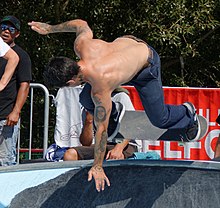Anticipation (sport)
Anticipation ( Latin anticipatio , anticipation ' ) describes in sports science the mental anticipation of a future sequence of movements.
The forward-looking mental anticipation can refer to a movement sequence of the anticipating subject himself - such as a skier adjusts to the terrain immediately in front of him - as well as to the movement sequence of another - for example, in martial arts, an upcoming action by the opponent that comes from whose current posture and the assumed intention are mentally extrapolated .
In each of these cases, the current sensory impressions are used in comparison with existing memory contents in order to adjust to the imminent situation and to have suitable patterns of action ready. A readiness to act appropriate to the situation is largely based on unconscious action patterns; The transition from re / action patterns of controlled executed processes to conditioned reflexes can be fluid.
Anticipation plays an important role, especially in fast-paced sports such as table tennis or close combat sports, even if the athlete does not consciously notice it. High anticipation performances are achieved in bobsleigh and automobile racing, whereby it becomes clear that tactile and kinesthetic stimuli can be reacted to more quickly than acoustic or visual ones. Some movement sequences in sports would not be possible without anticipation, such as skateboarding tricks .
In sports games such as basketball, handball or volleyball, the drills of certain movement sequences and moves ensure that their rapid execution can surprise opponents whose ability to anticipate is overwhelmed. This applies in particular if deceptive movements in the sense of a feint are carried out with which opponents are tricked who as a result expect a different sequence than the intended one. In football, something similar is practiced in standard situations.
Through various training methods , especially mental training , it is possible to modify action patterns and expand the repertoire with variants that are available to the athlete. In this way, the reaction time as well as the frequency and extent of incorrect reactions can be reduced and thus the risk of injury.
Using imaging methods such as magnetic resonance imaging (MRT), neurophysiology has been able to demonstrate that, in complex movement sequences, similar activity patterns occur in some brain regions seconds before they are actually performed, as in the subsequent movements.
Individual evidence
- ↑ Gustav Weder : Optimal action - using the example of high speed: an empirical approach to the psychological regulation of optimal action based on the action spaces sport and aviation . Zurich 2002, ISBN 3-03708-001-9 .
- ↑ Arnd Krüger : The drill in basketball. Movement-theoretical prerequisite for anticipating movements. 2nd Edition. Hofmann, Schorndorf 1991, ISBN 3-7780-9572-2 , pp. 27-43.
- ↑ E. Binder, K. Hagelweide, L. Wang et al .: Sensory-guided motor tasks benefit from mental training based on serial prediction. In: Neuropsychologia. Volume 54, 2014, pp. 18-27.
